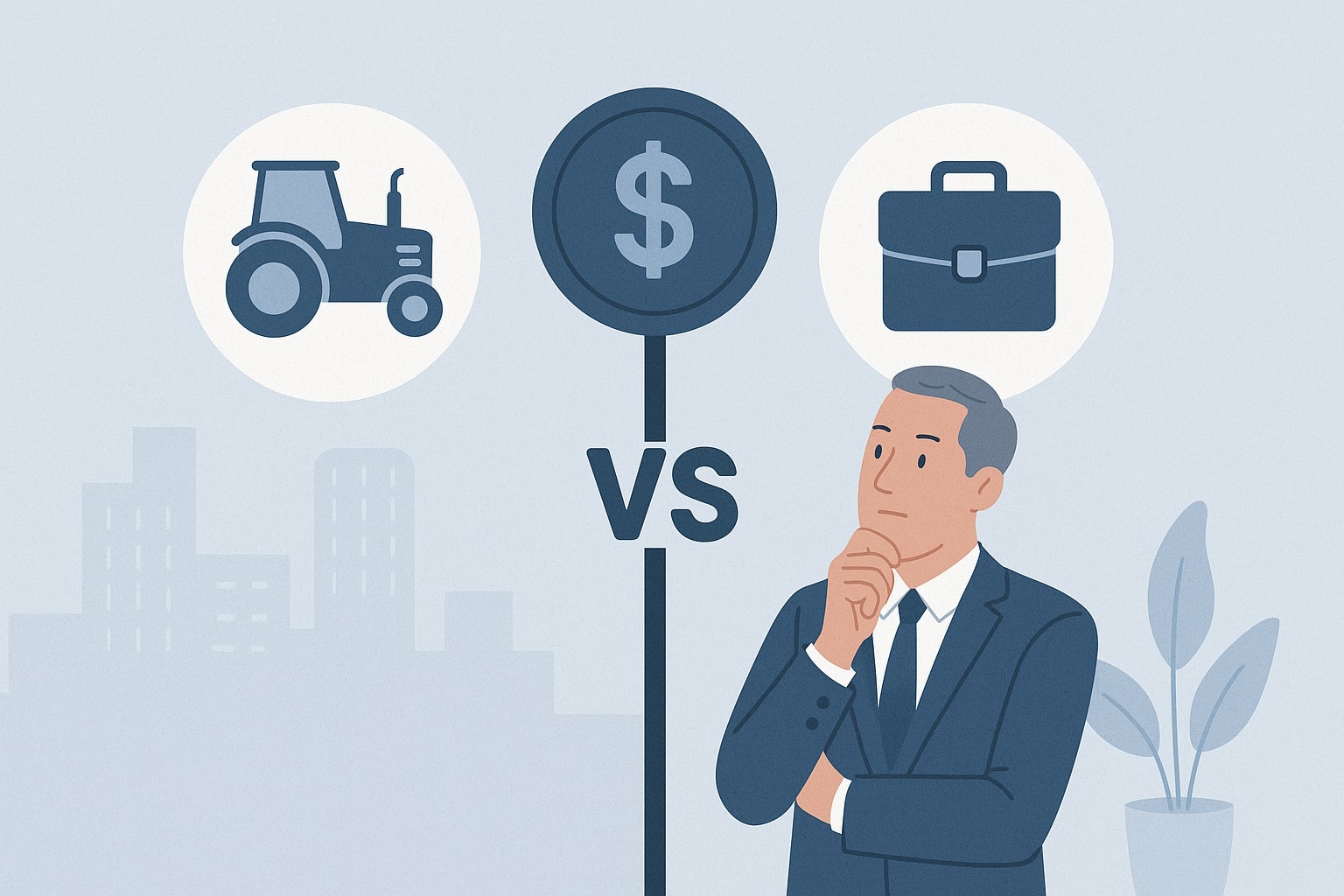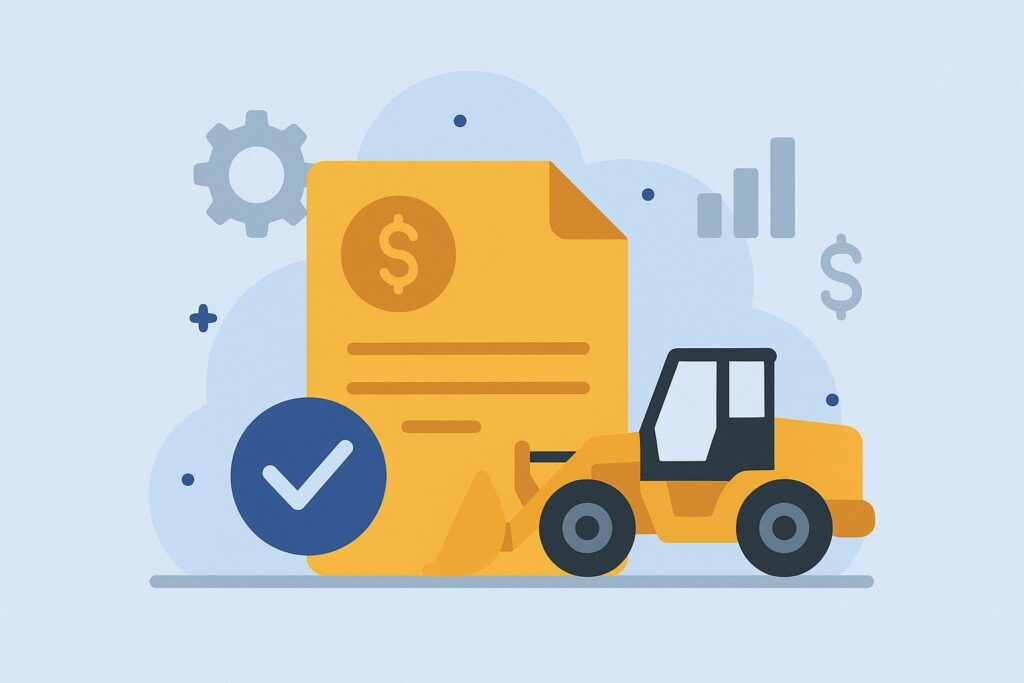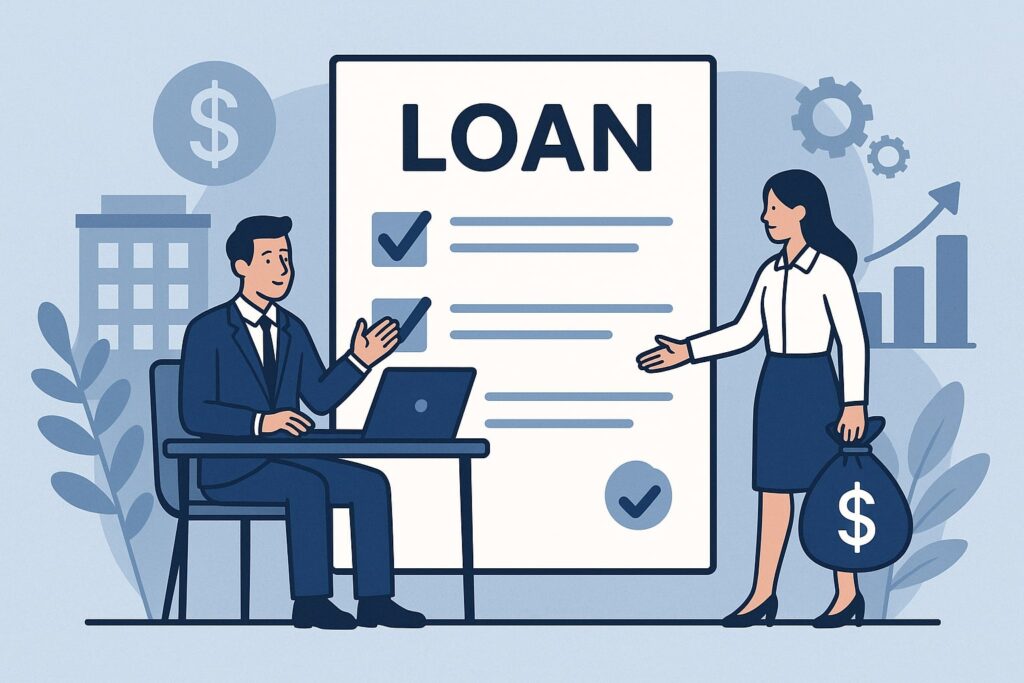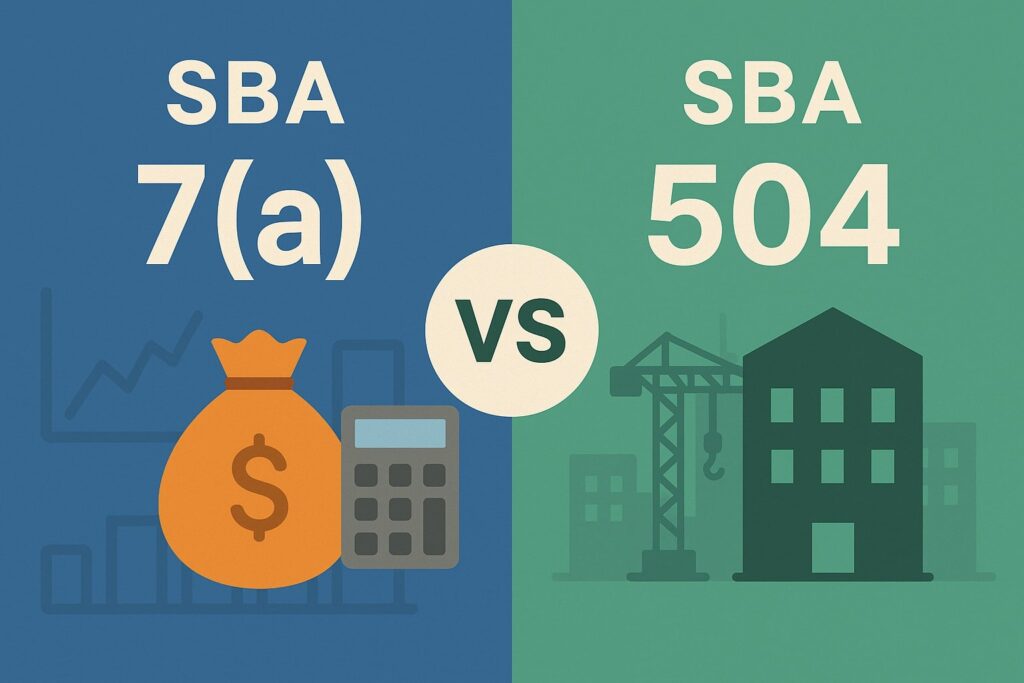
Equipment Loans vs Business Loans: Key Differences
Choosing between equipment loans and business loans shapes your cash flow, tax position, and growth runway. For U.S. small businesses in 2025, lending terms, collateral expectations, and tax incentives have shifted in meaningful ways—especially for firms buying machinery, vehicles, POS systems, or specialized tools.
This guide breaks down equipment loans vs business loans in plain English, so you can match the right financing to your goals, safeguard working capital, and optimize taxes without surprises.
Equipment loans are purpose-built for tangible assets—think excavators, ovens, embroidery machines, dental chairs, or manufacturing lines. Business loans (often called term loans) are general-purpose: working capital, marketing, payroll, inventory, or refinancing.
While both can fund growth, the structure, underwriting, security, and tax interactions differ. Understanding those differences can save you thousands in interest, reduce risk via smarter UCC-1 filings, and unlock significant deductions through Section 179 and bonus depreciation if you purchase eligible equipment.
What Is an Equipment Loan? (Definition, Use Cases, and How It Works)

An equipment loan is a secured loan tied to the item you’re buying. The equipment itself serves as collateral, which helps keep rates competitive and approvals practical for asset-heavy businesses.
Lenders assess the useful life, resale value, and installation/transport costs, then size the loan accordingly. This is especially attractive for businesses that want to preserve credit lines for working capital while acquiring mission-critical tools.
In the U.S., equipment loans typically fund new or used assets, including vehicles, fixtures, and heavy machinery. The lender may file a UCC-1 financing statement to perfect its security interest in the collateral, establishing priority over other creditors.
That public notice protects the lender and clarifies your obligations, especially if you later seek additional credit. The UCC system is standardized under Article 9 and governs how security interests attach and are perfected.
Understanding that framework helps you prevent conflicting liens, avoid unpleasant surprises at renewal, and maintain lender trust.
A key benefit of equipment loans is alignment: the financing term can match the asset’s useful life. Restaurants, contractors, clinics, and manufacturers frequently choose this path to keep payments predictable.
Because the loan is collateralized by the equipment, lenders often offer longer terms and potentially lower rates than unsecured options, assuming strong business fundamentals. When you compare equipment loans vs business loans, this built-in collateral can be the deciding factor for capital-intensive firms.
What Is a Business Loan? (General-Purpose Term Loans and Flexible Uses)

A business loan (general-purpose term loan) provides a lump sum you can use broadly—working capital, payroll buffering, inventory, marketing campaigns, or consolidating higher-cost debt.
Because funds aren’t tied to a specific asset purchase, you gain flexibility to react to seasonality, negotiate inventory discounts, or ramp up sales activity. For many service firms, this versatility is more valuable than asset-specific financing.
Unlike equipment loans, many business loans are unsecured or only partially secured. Without dedicated collateral, lenders lean harder on financials, cash flow coverage, time in business, credit quality, and sometimes personal guarantees.
That can mean shorter terms or higher rates compared to equipment loans. Still, strong borrowers with robust cash flow and clean financials can secure favorable pricing, especially via SBA-backed options like the 7(a) program, which guarantees a portion of the loan and broadens eligible uses of proceeds.
Understanding when to use a business loan—versus making it stretch to cover equipment—prevents cash flow strain and keeps your debt stack healthy.
Another consideration is lien position. Even when a loan is “general purpose,” many lenders file a blanket UCC-1 on business assets. This can affect your ability to add equipment financing later unless terms are negotiated up front.
If you expect near-term equipment needs, plan the order of financing—often equipment first, then working capital—to keep liens clean and avoid intercreditor conflicts.
Core Differences: Equipment Loans vs Business Loans (Collateral, Terms, Rates, and Uses)
When you compare equipment loans vs business loans, four differences stand out:
- Collateral and Liens: Equipment loans are usually secured by the equipment itself; lenders perfect their interest via a UCC-1 filing that describes the collateral. Business loans may be unsecured, selectively secured, or secured by a blanket lien on business assets.
The lien type impacts future borrowing capacity and the order in which creditors get paid if things go sideways. Understanding Article 9 priority rules—“first to file or perfect”—is crucial when layering multiple facilities. - Terms and Amortization: Equipment loans aim to match the asset’s useful life, producing manageable payments and minimizing the risk of owing money after the equipment is obsolete.
Business loans may have shorter maturities to manage lender risk on general-purpose proceeds. The closer your amortization aligns to asset life, the less you’ll overpay in interest or face negative equity at upgrade time. - Rates and Pricing: Because equipment is collateral, equipment loans can be priced more competitively than unsecured working-capital loans. Business loans may involve higher rates to compensate for broader use of funds and weaker collateral.
SBA guarantees can narrow this gap and provide longer maturities and capped fees under program rules. The 7(a) framework is designed to expand access where traditional underwriting might balk. - Eligible Uses and Documentation: Equipment loans require quotes, invoices, and asset details. Business loans require broader financial documentation to justify working-capital needs, inventory turns, or marketing ROI.
Your UCC-1 footprint also differs: equipment loans often list specific collateral, while business loans may record a blanket lien that touches accounts receivable, inventory, and equipment.
SBA Options That Touch Both: 7(a) vs 504 (When Each Fits Best)

The SBA 7(a) program is the government’s primary small-business loan guarantee. Proceeds can cover working capital, inventory, equipment, and even business acquisition. Terms, guarantees, and collateral policies are set by SBA but negotiated through participating lenders.
If you need one flexible loan that can fund both equipment and operations, 7(a) is often the go-to. Updates in 2025 emphasize prudent underwriting, with SBA clarifying standards after prior changes. This helps lenders balance reach with risk, keeping the program healthy for borrowers who truly need it.
The SBA 504 program is purpose-built for major fixed assets—owner-occupied commercial real estate, construction, and heavy equipment. It uses a two- or three-part structure (bank first-lien + CDC second-lien + borrower equity) to deliver long-term, fixed-rate financing.
For large, durable assets with long useful lives, 504 can lock in predictability and cash-flow-friendly amortization. Some 504 loans are assumable at sale of the building, and certain refinancing paths exist for eligible debt tied to owner-occupied real estate or equipment.
If your primary need is big-ticket machinery or a building for your operations, 504 is often a superior fit to a general business loan.
Tax Angles in 2025: Section 179 and Bonus Depreciation for Equipment Buyers
If you’re choosing between equipment loans vs business loans to acquire assets, 2025 tax rules matter. Section 179 allows eligible businesses to expense qualifying equipment up to annual limits.
According to IRS Publication 946, for tax years beginning in 2025 the maximum Section 179 deduction is $1,250,000, phased out dollar-for-dollar once total qualifying purchases exceed $3,130,000. There are special caps for certain SUVs.
This can materially lower your after-tax cost of equipment and improve year-one cash flow. Independent coverage aligns with the IRS figure for 2025, though commercial blogs sometimes speculate about changes. Always verify with a CPA.
Bonus depreciation is separate from Section 179. Several respected tax advisors report that legislation in 2025 restored 100% bonus depreciation for qualified property placed in service after January 19, 2025 (with special attention to acquisition/contract dates).
Prior law (the TCJA phase-down) would have meant 40% bonus in 2025 and 20% in 2026, but commentary from national accounting firms indicates a policy reversal to 100% from late January 2025 onward.
Because IRS administrative guidance and practitioner interpretations can differ during transitions, timing your purchase and “placed in service” date is critical. Coordinate with your tax advisor to determine whether your property and acquisition date meet the new rules.
Underwriting and Approvals: What Lenders Actually Look For
Whether you pursue equipment loans or business loans, expect a focus on repayment capacity. Lenders evaluate cash flow, debt service coverage, time in business, industry risk, and leverage. For equipment loans, the collateral’s value, age, and resale market factor heavily.
For business loans, broader financials—gross margins, recurring revenue, and customer concentration—carry more weight because proceeds aren’t backed by a specific asset.
SBA-backed lenders apply program standards for eligibility, permitted uses, collateral, and guarantees under 7(a) and 504. While each lender has its own credit box, SBA’s terms and conditions help harmonize expectations across the market.
Borrowers who prepare complete financials, realistic projections, and well-documented use-of-funds generally enjoy faster decisions and better structures. Keep in mind that policy tweaks in 2025 are aimed at strengthening underwriting quality, which ultimately supports stable access to capital for Main Street businesses.
For equipment-heavy firms, a prescreen that includes quotes, vendor details, serial numbers (when available), and installation lead times will streamline underwriting.
For working-capital term loans, a clear plan for inventory turns, campaign ROI, or payroll stabilization can be decisive. Being explicit about collateral and lien expectations at the term sheet stage avoids later conflicts with UCC filings.
Collateral, UCC-1 Filings, and Priority: Practical Implications for Owners
When you finance with either equipment loans or business loans, you’ll likely encounter UCC-1 financing statements. A UCC-1 is a public filing that “perfects” the lender’s security interest in your collateral.
It does not mean default; it’s simply notice to the world that a creditor has a claim. For equipment loans, the filing often lists specific equipment. For business loans, some lenders file a blanket lien covering “all assets,” which can complicate future financing if not coordinated.
Priority among creditors generally follows “first to file or perfect,” which matters if you stack multiple facilities. If you know you’ll need an equipment loan within six months, discuss intercreditor agreements up front so your working-capital lender doesn’t inadvertently block the equipment lender’s first-priority interest.
The UCC framework in Article 9 outlines how security interests attach, are perfected, and maintain continuity—knowledge that helps you negotiate better terms and avoid a financing dead-end just when growth is taking off.
In practice, request a copy of any draft UCC collateral description before signing. Verify whether proceeds are limited to specific equipment or if the lien is blanket.
If your lender insists on a blanket lien for a business loan, negotiate carve-outs for future equipment financing or secure a subordination agreement. These steps preserve flexibility for the next opportunity.
Cost and Terms: Rates, Fees, Amortization, and Prepayment
Cost of capital isn’t just the interest rate. With equipment loans vs business loans, consider origination fees, packaging fees (common with SBA), documentation fees, prepayment penalties, and any interim interest during equipment delivery.
Equipment loans frequently offer fixed rates and terms synced to useful life; business loans may be fixed or floating and shorter.
SBA programs add structure: 7(a) and 504 include guidelines for maximum maturities, fee caps, and guarantee fees. The tradeoff for that structure can be longer processing times and additional documentation—but the benefit is longer terms and potentially lower blended cost once guarantees are considered.
If your equipment is core to revenue and retains value, a longer fixed-rate schedule reduces interest-rate risk and keeps working capital free for day-to-day operations.
Always model total cost of ownership (TCO). Include maintenance contracts, software licenses (for smart equipment), operator training, and likely replacement cycles.
With these inputs, you can calibrate loan terms to the realistic economic life of the asset. If technology cycles are rapid, avoid terms that outlast usefulness—you don’t want to finance a device over 7 years that you’ll replace in 3.
Cash Flow and Accounting: Matching Debt to Asset Life and Tax Timing
When comparing equipment loans vs business loans, cash flow matching is everything. Equipment loans typically amortize over the asset’s life, keeping payment schedules aligned with productivity gains.
That reduces the risk of paying for equipment long after its peak revenue impact. On the tax side, pairing equipment financing with Section 179 or bonus depreciation can supercharge first-year savings.
If you can deduct much or all of the equipment cost in year one, you essentially “pull forward” tax benefits while spreading cash payments over time. That’s a powerful combination for growth.
For business loans, the accounting is straightforward: you carry the liability and expense interest; there’s usually no direct tie to a specific depreciable asset. That’s ideal when needs are non-asset-based—inventory build-ups, seasonal staffing, or marketing sprints.
But if you’re buying equipment, using a general-purpose business loan can muddy your asset-liability matching and potentially limit tax acceleration opportunities vs a dedicated equipment loan structure.
When Equipment Loans Win (And When Business Loans Win)
Choose equipment loans when you’re acquiring durable assets with reliable resale value, where the collateral supports longer terms and competitive rates.
The structure meshes with tax incentives, and the UCC filing can be tailored to the specific equipment—reducing friction with other lenders. If you want fixed payments and clear upgrade cycles, equipment financing is often superior.
Choose business loans when your need isn’t asset-specific: working capital, inventory, payroll, marketing, or small expansions that don’t require machinery. The funds’ flexibility makes a business loan compelling, even if rates are a bit higher.
SBA 7(a) can bridge both uses if you prefer one facility for simplicity; SBA 504 leans toward real estate and heavy equipment. Matching the tool to the job avoids overpaying and keeps your capital stack nimble.
For many firms, the optimal strategy is both: finance machines with equipment loans (leveraging Section 179 and bonus depreciation), and use a business loan for seasonal working capital. Coordinate UCC filings to protect borrowing capacity across lenders.
Compliance, Documentation, and Common Pitfalls to Avoid
Documentation rigor differs between equipment loans vs business loans. For equipment, gather quotes, warranties, installation timelines, and insurance evidence early.
For business loans, assemble historical financial statements, tax returns, AR/AP agings, and a simple narrative explaining use of proceeds and payoff plan. A clean file shortens underwriting.
Three pitfalls stand out. First, ignoring UCC-1 implications can box you out of future financing; always negotiate lien scopes and intercreditor terms up front. Second, mismatching terms to useful life can leave you paying for obsolete equipment.
Third, missing tax timing—especially in 2025’s shifting landscape for bonus depreciation—can cost you meaningful dollars. Keep your CPA involved before you sign, confirm placed-in-service dates, and preserve documentation.
SBA borrowers should also track program guidance. SOP 50 10 defines origination policies for 7(a) and 504; lender overlays still apply. Check for the latest forms and eligibility notes, particularly if your use of proceeds spans working capital and fixed assets in a single facility.
Step-By-Step: How to Decide Between Equipment Loans and Business Loans
1) Define your needs precisely: If you’re buying a tangible asset, list specs, cost, and expected life. If you need working capital, detail the cash conversion cycle or campaign plan.
2) Map tax outcomes: Ask your CPA to model Section 179 vs bonus depreciation given your 2025/2026 income and the asset’s placed-in-service timing. Laws and thresholds can change; IRS Pub 946 remains your lodestar while professional advisories interpret mid-year shifts.
3) Optimize collateral strategy. Decide whether you’re comfortable with a blanket lien on a business loan or prefer asset-specific liens. If stacking facilities, pre-negotiate intercreditor terms so lenders won’t conflict over first priority on equipment.
4) Align amortization with asset life. For fast-moving tech, keep terms short; for durable machines, use longer fixed-rate options (including SBA 504 for heavy equipment/real estate).
5) Comparison-shop structure, not just rate. Consider fees, prepayment penalties, delivery/installation timing, and closing timelines. SBA 7(a) can consolidate uses; equipment loans can deliver lower cost for asset-backed purchases.
Advanced Topic: Purchase-Money Security Interests (PMSI) for Equipment
A purchase-money security interest (PMSI) gives the lender (or seller-financer) a special priority in the equipment you buy with their funds—often trumping prior blanket liens if perfected properly and timely.
PMSIs are powerful for borrowers too: they can enable new equipment financing even when an existing lender holds a broad UCC lien, provided the PMSI rules and notice requirements are satisfied.
If you’re negotiating with a primary bank and an equipment financier simultaneously, raise PMSI structuring early to preserve options.
The catch is timing and notice. Article 9 sets out specific rules for PMSI perfection and the order of priority. Your counsel or lender’s counsel will coordinate filings and creditor notices to ensure the PMSI holds.
Used well, PMSIs let you optimize equipment loans vs business loans—using targeted, first-priority liens on new machines while keeping working-capital lines intact.
Sector Examples: Restaurants, Construction, Healthcare, and E-commerce
- Restaurants & Foodservice: Ovens, hoods, refrigeration, and POS terminals are classic candidates for equipment loans. Tax expensing accelerates ROI, while the loan term matches useful life. Use a business loan for opening inventory, marketing, and staffing—don’t cross-collateralize if you can avoid it.
- Construction & Trades: Excavators, skid steers, and work trucks hold value and fit equipment financing well. Tooling upgrades can qualify for expensing. Business loans cover mobilization, materials float, and payroll between draws. Keep lien scopes clear so vendors and bonding providers stay comfortable.
- Healthcare & Dental: Imaging equipment, dental chairs, and lab tech often qualify for dedicated equipment loans. Because technology cycles can be brisk, structure terms to match upgrade intervals. A business loan can help with patient acquisition campaigns or staffing as your practice scales.
- E-commerce & Retail: Racking, forklifts, and packaging machines are equipment-loan-friendly; marketing and inventory are typically funded with business loans. If your working-capital lender insists on a blanket lien, negotiate carve-outs so a PMSI equipment financier can still take first priority on new gear.
FAQs
Q1. Which is cheaper: an equipment loan or a business loan?
Answer: Often an equipment loan is cheaper because it’s secured by the asset, which reduces lender risk. Business loans can price higher due to flexible use of proceeds and weaker collateral. SBA 7(a) guarantees can narrow the gap by de-risking the lender. Always compare total cost—rate, fees, and prepayment terms—across both options.
Q2. How do UCC-1 filings affect my ability to borrow again?
Answer: A UCC-1 perfects a lender’s security interest and sets priority. A blanket UCC on a business loan may limit future equipment financing unless you negotiate exceptions or PMSI priority for new gear. Review collateral descriptions before signing, and coordinate intercreditor agreements when stacking facilities.
Q3. Can I use SBA loans for both equipment and working capital?
Answer: Yes. SBA 7(a) supports broad uses, including equipment and working capital. SBA 504 targets fixed assets like owner-occupied real estate and heavy equipment with long-term, fixed-rate structures. Your choice depends on asset size, useful life, and whether you need flexible funds beyond the purchase.
Q4. What’s the difference between Section 179 and bonus depreciation in 2025?
Answer: Section 179 allows immediate expensing up to annual limits—$1,250,000 for 2025 with a $3,130,000 phase-out per the IRS.
Bonus depreciation is separate; several top tax firms report a return to 100% for property placed in service after Jan 19, 2025, subject to acquisition-date rules. Because guidance evolves, confirm your eligibility and timing with a CPA before closing.
Q5. Is leasing better than an equipment loan?
Answer: Leasing can conserve cash and simplify upgrades, but economics vary. True leases may keep the asset off your balance sheet depending on accounting rules, while finance leases behave similarly to loans.
Under the UCC, some “leases” are deemed security interests based on facts and terms. Compare present value of payments, end-of-term options, tax treatment, and upgrade cadence.
Q6. How fast can I close?
Answer: Equipment loans often close faster because documentation is built around a specific asset and vendor invoice. Business loans can take longer due to broader underwriting. SBA timelines vary by lender, structure (7(a) vs 504), and completeness of your package. A clean, well-labeled file speeds approvals.
Conclusion
If you’re buying a tangible asset, equipment loans usually win on structure, pricing, and tax synergy. They’re secured by the equipment, align terms to useful life, and may unlock Section 179 and bonus depreciation advantages that shrink your effective cost.
If you need flexible cash for operations, inventory, or campaigns, a business loan (including SBA 7(a)) provides breathing room without tying funds to a single asset. For big-ticket, long-life assets—especially owner-occupied real estate and heavy machinery—SBA 504 delivers long-term, fixed-rate stability.
To decide: define the use, model taxes with your CPA, set a collateral strategy, align terms to asset life, and comparison-shop the total cost. Manage UCC-1 filings proactively so today’s choice doesn’t block tomorrow’s growth.
With that roadmap, the equipment loans vs business loans decision becomes a strategic lever—not a guessing game.